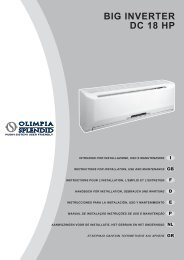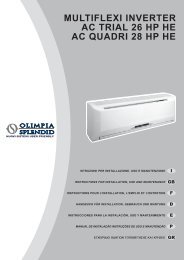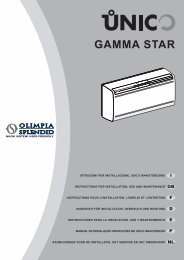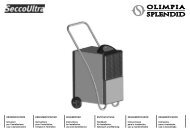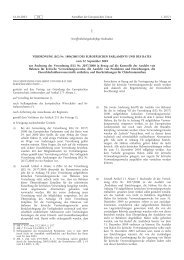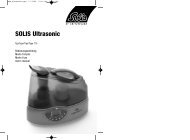manuale DIFFUSIONE BIG.pmd - KlimaShop!
manuale DIFFUSIONE BIG.pmd - KlimaShop!
manuale DIFFUSIONE BIG.pmd - KlimaShop!
You also want an ePaper? Increase the reach of your titles
YUMPU automatically turns print PDFs into web optimized ePapers that Google loves.
42<br />
12<br />
2.4.5<br />
Prove e verifiche<br />
23<br />
I GB F D<br />
Ultimati i collegamenti dei tubi occorre<br />
fare una verifica sulla perfetta<br />
tenuta dell’impianto:<br />
- Svitare il tappo di chiusura del<br />
raccordo di servizio della linea del<br />
gas (fig. 23 rif. A).<br />
- Collegare al raccordo una bombola<br />
d’azoto anidro con tubo flessibile<br />
con attacco da<br />
5/16” e riduttore di pressione.<br />
- Aprire il rubinetto della bombola ed<br />
il riduttore di pressione portando a<br />
3 bar la pressione del circuito;<br />
chiudere la bombola.<br />
- Se dopo circa tre minuti la pressione<br />
non diminuisce, il circuito è in<br />
condizioni ottimali, e la pressione<br />
può essere portata a 15 bar riaprendo<br />
la bombola.<br />
- Controllare dopo altri tre minuti che<br />
la pressione rimanga al valore di 15<br />
bar.<br />
- Per sicurezza applicare sugli attacchi<br />
una soluzione saponata ed<br />
individuare l’eventuale formazione<br />
di bolle, indice di fuoriuscita di gas.<br />
- In caso di calo di pressione e la<br />
ricerca con soluzione saponata<br />
sugli attacchi dia esito negativo,<br />
immettere nel circuito R410A e<br />
ricercare la fuga con un cercafughe.<br />
Essendo il circuito privo di punti di<br />
saldatura, le fughe si dovrebbero<br />
presentare solo nei punti di giunzione<br />
delle tubazioni, nel qual caso<br />
serrare con maggior forza i dadi,<br />
oppure rifare gli attacchi con le<br />
relative cartellature. Ripetere poi<br />
le prove di tenuta.<br />
Tests and inspection<br />
After making all pipe connections,<br />
check the seal of the system:<br />
- Unscrew the closing cap on the<br />
service coupling of the gas line (fig.<br />
23 ref. A).<br />
- Connect a tank of anhydrous<br />
nitrogen to the coupling with a 5/16"<br />
connector and a pressure reducer.<br />
- Open the tap on the tank and<br />
pressure reducer and bring the<br />
pressure in the circuit to 3 bar;<br />
close the tank.<br />
- If after about 3 minutes the pressure<br />
does not drop, the circuit is in good<br />
working order and the pressure can<br />
be raised to 15 bar by reopening the<br />
tank.<br />
- Check again after 3 minutes that<br />
the pressure remains stable at 15<br />
bar.<br />
- For safety reasons apply a solution<br />
of soapy water to the connectors<br />
and check for the formation of<br />
bubbles revealing leakage of gas.<br />
- In case of a pressure drop, if the<br />
tst with soapy water gives a<br />
negative result, pump R410A into<br />
the circuit and find the leak with a<br />
leak detector. Since the circuit has<br />
no welds, the only place leaks can<br />
occur is on the joints, in which<br />
case, tighten the nuts thoroughly<br />
or make new connections after<br />
flaring the pipes again. Repeat the<br />
seal test.<br />
A<br />
Essais et vérifications<br />
Après avoir terminé les<br />
branchements des tuyaux il faut<br />
vérifier la parfaite étanchéité de<br />
l’installation:<br />
- Dévisser le bouchon de fermeture<br />
du raccord de service de la<br />
conduite du gaz (fig. 23 réf. A).<br />
- Brancher au raccord une bouteille<br />
d’azote anhydre à l’aide d’un<br />
flexible avec raccord de 5/16” et<br />
un détendeur.<br />
- Ouvrir le robinet de la bouteille et<br />
le détendeur en portant à 3 bars la<br />
pression du circuit; fermer la<br />
bouteille.<br />
- Si au bout de trois minutes environ<br />
la pression ne diminue pas, le<br />
circuit est dans des conditions<br />
optimales, et la pression peut être<br />
portée à 15 bars en rouvrant la<br />
bouteille.<br />
- Contrôler après trois autres<br />
minutes que la pression reste à la<br />
valeur de 15 bars.<br />
- Par sécurité appliquer sur les<br />
raccords une solution savonneuse<br />
et repérer l’éventuelle formation<br />
de bulles, indice de sortie de gaz.<br />
- En cas de baisse de pression et<br />
si la recherche avec une solution<br />
savonneuse sur les raccords donne<br />
un résultat négatif, introduire<br />
dans le circuit du R410A et<br />
rechercher la fuite avec un<br />
détecteur de fuites.<br />
Etant donné que le circuit est sans<br />
points de soudure, les fuites<br />
devraient se trouver seulement<br />
dans les points de jonction des<br />
tuyaux, dans ce cas serrer les<br />
écrous avec plus de force, ou bien<br />
refaire les raccords avec les<br />
relatives préparations des<br />
extrémités des tuyaux.<br />
Répéter ensuite les essais<br />
d’étanchéité.<br />
Überprüfungen<br />
Nachdem die Rohre angeschlossen<br />
wurden, ist die Anlage auf ihre<br />
Dichtigkeit zu überprüfen:<br />
- Den Verschlussstopfen des<br />
Anschlussstückes der Gasleitung<br />
ausschrauben (Abb. 23 - A).<br />
- An das Anschlussstück (mittels<br />
eines mit einem Anschlussstück<br />
5/16" und einem Druckminderer<br />
versehenen Schlauchs) eine<br />
Flasche anhydrischen Stickstoffes<br />
anschließen.<br />
- Den Hahn der Flasche und den<br />
Druckminderer aufdrehen und den<br />
Druck im Kreislauf auf 3 Bar<br />
einstellen. Den Hahn der Flasche<br />
wieder zudrehen.<br />
- Ist der Druck nach ca. 3 Minuten<br />
nicht gesunken, funktioniert der<br />
Kreislauf einwandfrei und der<br />
Druck kann durch Aufdrehen des<br />
Hahns auf der Flasche auf 15 Bar<br />
erhöht werden.<br />
- Nach weiteren 3 Minuten ist zu<br />
überprüfen, ob sich der Druckwert<br />
immer noch auf 15 Bar befindet.<br />
- Sicherheitshalber eine<br />
Seifenlösung an den<br />
Anschlussstücken anbringen und<br />
überprüfen, ob sich Luftblasen<br />
(Ausströmen von Gas) bilden.<br />
- Sinkt der Druck, auch wenn sich<br />
keine Luftblasen bilden, R410A in<br />
den Kreislauf geben und mit einem<br />
Leckortungsgerät die Leckage<br />
suchen. Da der Kreislauf keine<br />
Schweißstellen aufweist, könnten<br />
die Leckagen nur an den<br />
Verbindungsstellen der<br />
Rohrleitungen auftreten. In diesem<br />
Fall sind die Muttern fester zu<br />
spannen oder die Anschlüsse mit<br />
den entsprechenden<br />
Begrenzungsanschlägen<br />
vorzunehmen. Die<br />
Dichtigkeitsprüfungen<br />
wiederholen.



